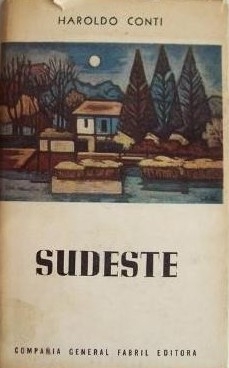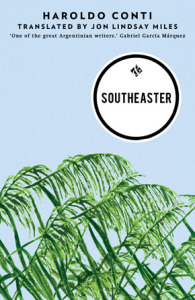Autobiography of a reader
by Jon Lindsay Miles
First Argentinian edition. Compañia General Fabril Editora, 1962
I translate for myself, then for the novel, finally for any future reader. It is for the pleasure of the work of translating that I do it, but I can only begin when I meet a text that moves me as a reader – which for me means to write. Haroldo Conti’s Sudeste was the first to make me want to pick up my pen and work my reading of a Spanish-language novel into English.
I first came upon a 1985 Spanish edition of Sudeste, published by Alfaguara, in the public lending library in my hometown of Úbeda. I blew off the dust of Andalusia and read the first paragraphs on my feet, between the shelves. A second reading a couple of years later convinced me this should be my first translation, and that I would publish the resulting text myself, simply as a way to ensure the novel would not have to wait another fifty years to be read in English.
It was the rhythmic sensibility that drew me into the novel, the rhythms ever-present in Conti’s narrative style, reinforced and intensified by the cycle of the seasons and the movements of nature around the rivers of the Paraná Delta, the intervals of the protagonist Boga’s journeys and the laconic dialogues with those he comes across in his wandering. It was this that formed my reading of Sudeste, and would in turn shape the writing of my translation.
It became important to visit the world of the novel – to clarify aspects of local and boating vocabulary, but also just to see the place. I experienced two of the huge surges of water that are a feature of the geography of the Delta, the second of which was uncommonly severe. Strong southeasterly winds literally pile up water from the River Plate – effectively the southern Atlantic – and send it across the islands of the Delta, where the water level on the second occasion rose to almost three metres above the ocean. I spent three nights with the water slapping about under the small wooden house I stayed in – just as Boga does one night; but I didn’t have a boat to lose, as he did.
The first act of every morning on the Delta is to draw back the curtains and look outside, for the activity of every day – quite often of each hour – is determined by the state of the river.

First English-language edition. Immigrant Press, 2013
Once the personal pleasure – the labour of translating – was satisfied, my ‘job’ was to be an advocate for Conti’s novel, by preparing and editing, designing and publishing the book in a small edition, and giving copies to people who might help find a major publisher to offer it to a wider reading public. I was lucky when Stefan Tobler of And Other Stories decided the translation was worth a punt and now, after five years’ working with Haroldo, his first novel reaches readers as Southeaster this summer, in London and New York.
I regard this translation as my reading of Conti’s novel, rather than any kind of definitive interpretation of or commentary on the novel in Spanish I took from the shelves. What I am translating is the intellectual, emotional and aesthetic force the book has had for me – its beauty – from the first time I picked it up. In that sense my translation comprises the autobiography of my own encounters with Conti’s novel. The many thousands of decisions made during the translating were decided by my particular reading. Naturally, it follows that there are as many potential versions of a novel as there are translators – and as many interpretations as readers.
It is not a common attitude, but I like Borges’ idea that all translations are legitimate, and as legitimate as the original texts they accompany 1; to me, it legitimises the individual experience of art, the liberty of the audience.
I enjoy reading translations that have something significant of the creative – rather than simply interpretive – qualities of the original work. To my mind this is a matter of the expressive, or ‘writing’ skills of the translator (the survival of which can depend to an important degree on the editor of the text prior to publication). There may be differing lists of what these skills include, but it astonished me to discover, during postgraduate studies at the University of East Anglia eight years ago, that few studies and “little effort had been devoted to the way a translator, after having analysed and understood the meaning of a text, manages to re-express that meaning successfully. [Rather,] most, if not all, methods and models focus on the first phase of the translation process, i.e. comprehension. It is assumed that expression will follow almost automatically” 2. It does not require the reading of many interviews with writers in The Paris Review to establish this assumption as erroneous.
A deeper discussion of the expressive skills in translation is for another time, but one of the benefits of publishing an edition of Conti’s novel myself was that of having time to complete the work without a deadline. Producing a translation is a labour one ought not to hurry, any more than reading Conti’s novel suggested to me that he ended the work before he felt it was properly done. (Receiving no payment for the work is just the most obvious disadvantage of such a choice.)
I am not engaged by discussions of ‘faithfulness’ in translating. It strikes me as a notion arguing for the kind of ‘authority’ and ‘ownership’ likely to produce dead interpretations, rather than living translations of books, and asserts one or other element of a text as deserving of special protection, to which any translator must bend her work.
It is, of course, always for the individual reader to prefer one or other reading of a text, which is why there is space for all translators and translations. As a reader I do like to know something of what Edward Said called the personal inventory of the writer (or translator), so as to place her text in its proper context.
In the personal inventory I requested be included as an afterword to the new edition, I conclude that what matters to me in translating is to produce a text that is in itself worthy of the time readers might spend with it. This is the only ‘faithfulness’ I recognise, one directed to the larger world of literature. It is a credit to Stefan Tobler’s vision for And Other Stories that he agreed.
1 Sergio Waisman, Borges and Translation. The Irreverence of the Periphery, Lewisburg: Bucknell University Press, 2005
2 Georges L. Bastin, ‘Evaluating Beginners’ Re-Expression and Creativity: A Positive Approach’ in The Translator, Vol. 6, No. 2, 2000, pp. 231–45
 Jon Lindsay Miles lives and works in southern Spain, where he publishes as Immigrant Press and teaches English conversation at an outpost of the University of Jaén. His translation of Southeaster is published by And Other Stories in paperback and eBook. Read more.
Jon Lindsay Miles lives and works in southern Spain, where he publishes as Immigrant Press and teaches English conversation at an outpost of the University of Jaén. His translation of Southeaster is published by And Other Stories in paperback and eBook. Read more.
immigrantpress.org
@ImmigrantPress
Haroldo Conti was born in the province of Buenos Aires in 1925. After the publication of Southeaster in 1962, he went on to write three more novels and several short story collections. He is the recipient of several important literary prizes, including the Casa de las Américas Prize. He was arrested after Argentina’s military coup in 1976, and remains on a list of the ‘permanently disappeared’.
“Conti is a writer for whom place is character, not backdrop, and what a place, what a character. He’s a revelation.”
Tim Winton


